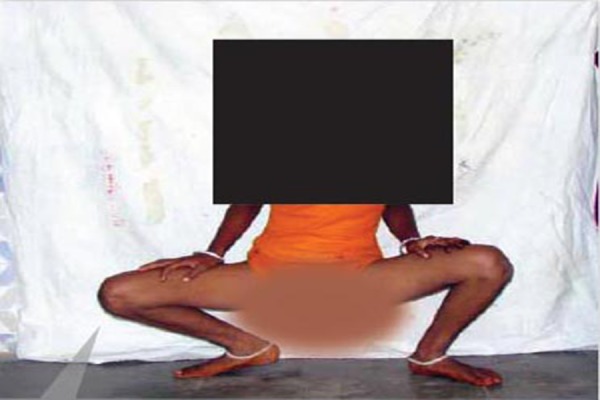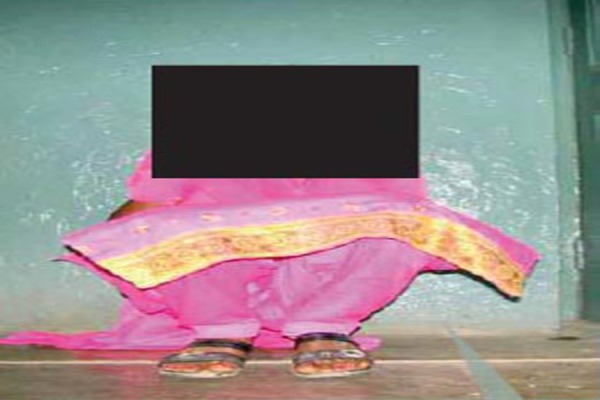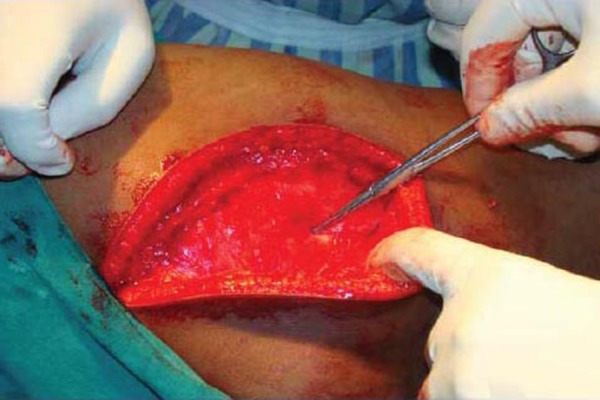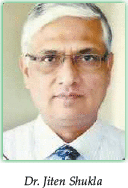Abstract
Introduction:
Bilateral gluteus muscle contracture is a rare entity. “Idiopathic contracture of gluteus maximus” a term proposed by Gao is a rare condition. It present as typical complain of inability to squat with patient assuming a typical frog leg position.
Case Report:
We report a case of idiopathic gluteal muscle contracture in adolescent female presenting with inability to squat, sit cross legged and painless awkward gait. The patient could not sit comfortably except in a high chair position. No history of repeated intramuscular injections in the buttocks or signs suggestive of post-polio residual paralysis. All her investigations were within normal limit. Our patient belonged to type III according to GMC classification and underwent surgical release of fibrotic band of gluteal maximus muscle. Patient had remarkable recovery with patient able to squat and sit cross-legged within 4 weeks of surgery.
Conclusion:
Gluteal maximus contracture, though rare, present with characteristic clinical symptom and should not be missed. Our patient though presented late showed excellent result after surgical release.
Keywords: Idiopathaic, bilateral, gluteus maximus, contracture
Introduction
Contractures of deltoid or quadriceps are well known, leading to the limitation of shoulder or knee joint movement. “Idiopathic contracture of gluteus maximus” a term proposed by Gao is a rare condition [1] there are only four case reports from the Indian subcontinent [2-5].
Case Report
A 16-year old female presented to the orthopedics outpatient department with complain of inability to squat, sit cross-legged and painless awkward gait for about last six years. Detailed birth history could only reveal that she was delivered through normal vaginal route at home and cried immediately after birth. She was normal at birth but when she started walking at the age of 15 months, there was a waddle. She had difficulty in walking and running since early childhood because of the need to abduct and externally rotate the limb in every step. The patient could not sit comfortably except in a high chair position. No history of repeated intramuscular injections in the buttocks was forthcoming. There was no history or signs suggestive of post-polio residual paralysis.
On examination she had an abnormal gait with lower limb kept in the attitude of external rotation and abduction while taking each step. Inspection showed a depressed groove over the skin of the buttock running along the course of the gluteus maximus muscle bilaterally, and no skin puckering was observed There was a typical restriction of movement, so that both hips could not be flexed or extended in the usual saggital plane (between 30° to 90°) with the hip in neutral position, adduction was limited and squatting was possible in typical frog leg position (Fig. 1). In 0-30° both hips could be flexed in saggital plane but while attempting more flexion there was external rotation and abduction. On flexion of the hip the knee was going to the ipsilateral axilla. However the hip joint could be flexed to 110° in wide abduction (Video 1). Hip rotations were full and free. According to GMC (Gluteal muscle contracture) classification [5] the patient belonged to severe/level III type. Radiographic findings were within normal limit no iliac hyperdense line was seen and fibrosis of postero-inferior fibers of gluteal maximus was seen in MRI.
Figure 1.

Preoperative clinical photograph of patient showing typical “frog leg position” on attempted squatting
There was no other associated abnormal contracture of deltoid or quadriceps. No abnormality was detected during spine examination.
Surgical release of bilateral contracture was planned in two separate identical operations for each side with a gap of one week to reduce the operative trauma. The procedures were done through postero-lateral approach with incision extending over the visible skin groove. The skin and subcutaneous tissues are reflected to expose gluteal aponeurosis at its attachment to iliotibial band. A dense fibrotic band extending from the gluteal fascia into the gluteus maximus muscle in the postero-inferior part of the muscle was found. The band was divided after visualization of the sciatic nerve. The hip was progressively flexed in saggital plane intraoperatively to ascertain the effectiveness of release.
No immobilization or traction is given in immediate postoperative period. Patient was encouraged to sit on bed from second postoperative day. The patient was hospitalised till stitch removal (11th post op day) and graduated exercise was begun. There was remarkable recovery with patient able to squat and sit cross-legged within 4 weeks of surgery with hip flexion of 120° and hip adduction being 10° (Fig. 2). There was no loss in gained movement till 12 months postoperatively after which the patient was lost to follow up.
Figure 2.

Postoperative photo showing patient being able to squat after bilateral gluteal release
Figure 3.

Deep groove seen on posteromedial aspect of gluteus maximus muscle
Discussion
Idiopathic bilateral gluteal muscle contracture is a rare occurrence, though other muscle such as quadriceps and deltoid are involved more frequently. Few ethinicities, especially Chinese have a relatively high prevalence of gluteal maximus muscle contracture [7, 8].
Various etiological causes have been proposed for muscle contracture irrespective of location viz. genetic or congenital and post natal, but still disease origin seems to be obscure. In all reported cases of gluteal muscle contracture repeated intramuscular injection is most widely documented[7,8,9]. The inflammatory reaction incited by intramuscular injections of antibiotics may play an important role in the quadriceps contracture [6,7,10]. Though no such history could be elicited in our case, but it cannot be ruled out. In our patient a detailed history did not revealed any incidence of suppurative infection in buttock region. None of the family member had any such complaints.
Gluteus maximus contracture produces a backward pull on the three pronged attachment of iliotibial tract displacing its axis posteriorly in relation to femur. Contracted gluteus maximus act as a checkrein decreasing the forward flexion of femur producing the characteristic deformity [7, 10]. Flexion at hip is grossly restricted in saggital plane and hip could only be flexed while keeping it in abduction and external rotation producing the frog leg position.
Table 1.
Classification of gluteal muscle contracture [6]
| Classification of gluteal muscle contracture2 | |
|---|---|
| Category according to level | |
| Level I (mild) | The extorsion of lower limb is mild, the abduction contracture is less than 15° with both hip and knee joint in 90° of flexion or adduction range is less than 20° with no flexion. Ober’s sign and frog squatting sign is weakly positive. The limp gait is not apparent with lateral inclination of pelvis on anteroposterior radiograph being less than 10° |
| Level II (moderate) | The extorsion of lower limb is moderate, the abduction contracture ranges from 15° to 60° with both hip and knee joint in 90° of flexion or adduction range is less than 10° with no flexion. Ober’s sign and frog squatting sign is positive. The limp gait is apparent with lateral inclination of pelvis on anteroposterior radiograph being less than 20° |
| Level III (server) | The extorsion of lower limb is severe, the abduction contracture is more than 60° with both hip and knee joint in 90° of flexion or adduction range is less than 0° with no flexion. Ober’s sign and frog squatting sign is strongly positive. The limp gait is remarkably apparent with lateral inclination of pelvis on anteroposterior radiograph being more than 20° |
| Category according to type | |
| Type MA | Gluteus maximus contraction type |
| Type MEI | Gluteus medius and minimus contraction type |
| Type AGM | Gluteus maximus, medius and minimus contraction type (All gluteal muscle contraction type) |
Previous studies on Gluteal maximus contracture had patients in younger age group at the time of intervention [1, 6, 8, 10] as compared to our patient (Table 3). Age was one important factor which influenced the final result, which suggested that either non operative method or surgery should be carried out as early as possible [6]. But our patient being 16 years old showed remarkable result and was able to sit cross legged and squat within 4 weeks of surgery probably due to rigrous physiotherapy regimen. Treatment guidelines have been delineated quite precisely by Zhao CG et al. according to the severity of disease [6]. The diagnosis of GMC mainly depends on anamnesis, and typical clinical manifestations; X-ray and MRI studies would not be requisite, but could always help eliminate other osteopathologic changes and make available additional information before surgery [6]. Passive stretching and manipulation is of no value in treating the deformity in severe/level III gluteal muscle contracture. Complete surgical release of the fibrotic band is only way to correct the deformity. In our case fibrotic band was along the postero-inferior aspect of gluteus maximus contracture, but Gao had reported it to be located in anterior part of the muscle [2]. We did open surgical release of gluteal contracture with on table assessment of release by flexing the hip in saggital plane. Arthroscopic gluteal maximus muscle contracture release by radiofrequency energy has been tried recently with encouraging result [11].
Table 3.
Review literature of previous studies on Gluteal Maximus Contracture
| No | Author | No of patients | Age (Mean) | Treatment given | Result |
|---|---|---|---|---|---|
| 1 | Gao G X (1988) [1] | 27 | 8.5 years (3-14) | Operative in all patients | All patients underwent surgical release of the fibrotic contracture tissue of gluteus maximus with good result. |
| 2 | Zhao C G (2009) [6] | 158 | 7.4 years (4-17) | Both operative and nonoperative based on type of involvement | Non-operative treatment had limitation with effectiveness of 38.8% And operative treatment leading to 83.7% excellent result. |
| 3 | Hang Y S (1979) [8] | 28 | 9.2 years (5-15) | Operative treatment in all patients | Author described result as gratifying with all patients achieving flexion between 90120° & hip adduction within normal limit |
| 4 | Peiro A (1975) [10] | 5 | 5 years (2 -6) | Operative treatment in all patients | All patient had excellent result with flexion between 90-120° and adduction was the most limited movement |
Table 2.
Recommendation of treatment strategy [6]
| Levels of Patients | Recommendation of treatment strategy |
|---|---|
| Level I | NOM as first choice, operation as recruitment treatment. Interogluteal incision or use arthroscopic technique is recommended. |
| Level II | Operative management as first choice, NOM as choice for recruitment treatment for waiting for operation or after operation. Surgeons could adopt interogluteal incision or use arthroscopic technique depending on the condition of patients. |
| Level III | Operative management as first choice, NOM as choice for recruitment treatment for waiting for operation or after operation. Operation under direct-viewing with conventional incision is commended, in order for complete releasing. |
Conclusion
Idiopathic bilateral gluteal maximus contracture is an uncommon entity, should be managed by operative release of the fibrotic band so as to obtain gratifying results. Our patient, though presented late, showed excellent result which points that even late intervention can give good results and should be offered to the patient.
Clinical Message.
Bilateral gluteus muscle contracture is a rare entity. It present as typical complain of inability to squat with patient assuming a typical frog leg position. This uncommon disease may be missed because of its rare occurance. A simple single stage procedure will be able to correct the deformity and will have great impact on patients life
Biography


Footnotes
Conflict of Interest: Nil
Source of Support: None
References
- 1.Gao GX. Idiopathic contracture of the gluteus maximus muscle in children. Arch Orthop Trauma Surg. 1988;107:277–279. doi: 10.1007/BF00451506. [DOI] [PubMed] [Google Scholar]
- 2.Pandey S, Jha SS. Congenital bilateral contracture of the gluteus maximus. Int Surg. 1976 Jan;61(1):49–50. [PubMed] [Google Scholar]
- 3.Yadav SS. Extension contracture of the hip due to idiopathic fibrosis of the gluteus maximus. Int Surg. 1978 Jan;63(1):27–8. [PubMed] [Google Scholar]
- 4.Patel DA, Patel BJ. Gluteal maximus contracture. Ind J Orthop. 1987;21:57–60. [Google Scholar]
- 5.Aggarwal A, Singh S, Singh M, Chauhan R. Idiopathic bilateral gluteus maximus contracture: a case report and review of literature. Acta Orthop Belg. 2005 Aug;71(4):493–5. [PubMed] [Google Scholar]
- 6.Zhao CG, He XJ, Lu B, Li HP, Wang D, Zhu ZZ. Classification of gluteal muscle contracture in children and outcome of different treatments. BMC Musculoskelet Disord. 2009 doi: 10.1186/1471-2474-10-34. [DOI] [PMC free article] [PubMed] [Google Scholar]
- 7.Peter F. Williams Quadriceps Contracture. J Bone Joint Surg Br. 1968 May;50-B:278–284. [PubMed] [Google Scholar]
- 8.Hang YS. Contracture of the hip secondary to fibrosis of the gluteus maximus muscle. J Bone Joint Surg. 1979;61-A:52–55. [PubMed] [Google Scholar]
- 9.Ni B, Li M. The effect of children's gluteal muscle contracture on skeleton development. Sichuan Da Xue Xue Bao Yi Xue Ban. 2007 Jul;38(4):657–9. 677. [PubMed] [Google Scholar]
- 10.Peiro A, Fernandez CI, Gomar F. Gluteal Fibrosis. J Bone Joint Surg Am. 1975 Oct;57(7):987–990. [PubMed] [Google Scholar]
- 11.Liu YJ, Wang Y, Xue J, Lui PP, Chan KM. Arthroscopic gluteal muscle contracture release with radiofrequency energy. Clin Orthop Relat Res. 2009;467:799–804. doi: 10.1007/s11999-008-0595-7. [DOI] [PMC free article] [PubMed] [Google Scholar]


